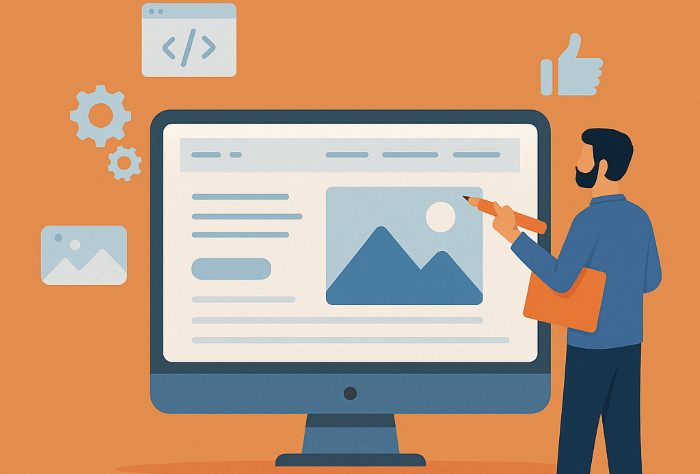In 2025, your website is no longer just an online presence—it’s the digital storefront of your brand. Whether you’re a consultant, a boutique owner, or a service provider in Kharghar or Navi Mumbai, your customers are likely to visit your website before they ever contact you.
Table of Contents
ToggleBut what happens when that website is outdated, slow, or hard to navigate?
Most small business owners know their site “could be better,” but they hesitate to redesign due to cost, time, or fear of losing content or SEO. The truth is, a well-planned website redesign can do more than make your site look good—it can significantly boost your leads, conversions, and customer trust.
In this guide, you’ll discover:
When it’s the right time to redesign
What changes truly matter
How to plan and execute a redesign that gets results
1. What Is a Website Redesign?
A website redesign is more than a visual update. It’s a strategic overhaul of how your website looks, functions, and performs.
It may involve:
A new layout and navigation structure
Mobile responsiveness
Improved content and call-to-actions
Updated branding and visuals
Faster load times
Enhanced SEO and schema setup
The goal of a redesign isn’t just aesthetics—it’s to make your website more effective at meeting business objectives, whether that’s generating leads, improving user experience, or supporting your marketing efforts.
If your current website doesn’t reflect your brand or business direction, or if it frustrates users instead of guiding them, it’s probably time for a redesign.
2. Signs You Might Need a Website Redesign
Still not sure if you need a redesign? Here are clear signals:
🚩 Your website looks outdated
If your site was built more than 4–5 years ago and hasn’t changed, it’s likely behind current design standards. Old layouts, stock photos, and cluttered interfaces push users away.
📱 It’s not mobile-friendly
In a mobile-first world, your site must adapt seamlessly to phones and tablets. If users pinch and zoom or text overlaps on small screens, Google penalizes your rankings—and users bounce.
🐢 It loads slowly
Slow sites drive people away. Even a 1-second delay can reduce conversions by 7%. Use free tools like Google PageSpeed Insights or GTmetrix to check your performance.
📉 You’re not getting leads
If your forms, WhatsApp button, or calls to action don’t convert visitors into inquiries, something is broken—whether it’s the design, the copy, or the user flow.
🔄 Navigation is confusing
Too many clicks to find basic info like pricing or contact? That’s a problem. A clear, intuitive menu is critical for engagement.
🔍 You’re invisible in search
If your competitors are ranking higher, your site likely needs better structure, SEO, and mobile optimization.
🧱 You’ve rebranded or changed services
Your site should reflect your business today—not what you offered two years ago. Outdated content, old pricing, or missing services confuse potential clients.
3. Why Redesigning Matters (And Pays Off)
Redesigning your website is one of the few marketing activities that can:
Increase traffic (via better SEO)
Improve lead conversions (through better UX)
Build trust (with updated branding and credibility)
Here’s what you gain from a smart redesign:
✅ Better User Experience
Simple layouts, intuitive buttons, and clean content help users stay longer and take action.
✅ Improved SEO Rankings
Redesigns allow you to fix technical SEO issues, improve speed, use schema, and optimize keywords—all of which help rank higher.
✅ Faster Page Loads
A streamlined, well-coded site can load in under 2 seconds, which increases retention and satisfaction.
✅ More Leads & Sales
Strategically placed CTAs, WhatsApp integrations, and simplified forms convert visitors into clients.
✅ Modern, Mobile-First Design
You don’t just look professional—you look trustworthy and up-to-date.
✅ Alignment with Your Brand
Your website should reflect how you want to be seen today. A redesign gives you that chance.
4. Redesign vs. Rebuild: What's the Difference?
Redesign means keeping the backend or CMS (like WordPress) and updating design, layout, and content.
Rebuild is more comprehensive—it involves creating a new site architecture, possibly changing platforms, and reworking everything from scratch.
You should:
Redesign if the structure is okay but the UX or visuals are outdated.
Rebuild if your site is hard to manage, uses outdated tech, or no longer supports your growth needs.
5. Local SEO Considerations During Redesign
A poorly managed redesign can harm your search rankings—but a well-managed one can improve them.
Here’s how to protect and boost your local SEO:
Preserve URL structures where possible
Redirect any removed pages (301 redirects)
Reoptimize page titles and meta descriptions
Add/update schema for LocalBusiness, FAQ, and Services
Keep internal linking structure intact
Continue using location-based keywords like “web design in Kharghar”
Use Google Search Console to monitor indexing issues post-launch.
6. Step-by-Step Plan for Redesigning Your Website
Step 1: Audit Your Current Website
Use tools like GA4, Hotjar, and GTmetrix. What’s working? What’s not? Track bounce rate, engagement time, and page speed.
Step 2: Define Your Goals
Is it to generate leads, rank better, or support content marketing? Know this before touching design.
Step 3: Plan the New Structure
Sitemap basics:
Home
About
Services (individual pages)
Portfolio or Case Studies
Testimonials
Blog
Contact
Local pages like
/web-design-kharghar
Step 4: Update Your Content
Rewrite services with benefits. Add testimonials. Use simple, engaging copy that speaks to your customer.
Step 5: Choose Platform & Hosting
WordPress is perfect for small businesses. Use secure, fast hosts with SSL and daily backups.
Step 6: Design Responsively
Make it easy to read and navigate on mobile. Use consistent branding, clear CTAs, and adequate spacing.
Step 7: Test Everything
Check mobile view, forms, buttons, speed, internal links, and grammar. Ask 2–3 people to test usability.
Step 8: Launch with Care
Submit sitemap to Google. Reshare your new site on social and Google Business Profile.
7. Cost of Website Redesign for Small Businesses in Kharghar
Cost depends on scope and provider, but here are average ranges:
| Scope | Estimated Cost (INR) |
|---|---|
| Basic visual redesign | ₹5,000 – ₹9,000 |
| Redesign + SEO fixes | ₹10,000 – ₹15,000 |
| Full rebuild + content | ₹15,000 – ₹25,000 |
Note: At Go1Digital, we offer website design and redesign starting at ₹9,999, including SEO optimization, WhatsApp integration, and 1 month of support.
8. Mistakes to Avoid During Redesign
Forgetting redirects (causes 404 errors)
Overloading the homepage with content
Ignoring mobile responsiveness
Not testing forms and analytics after launch
Losing internal links or metadata
Changing all URLs without planning
9. After the Redesign: What to Track and Improve
Post-launch is critical. Don’t forget to:
Check Google Search Console for errors
Monitor traffic and conversions via GA4
Update your blog regularly
Keep loading time under 2 seconds
Add new testimonials or case studies each month
Track keyword rankings with a tool like Ubersuggest
Conclusion: Redesign is a Growth Strategy
Redesigning your website isn’t about making it “prettier”—it’s about making it work harder for your business.
If you’re a small business owner in Kharghar or Navi Mumbai, investing in a modern, SEO-friendly, mobile-optimized website can set you apart from the competition, improve your visibility, and help you win trust with every visitor.
Start with a plan. Focus on your users. Choose the right partner. And keep improving.

